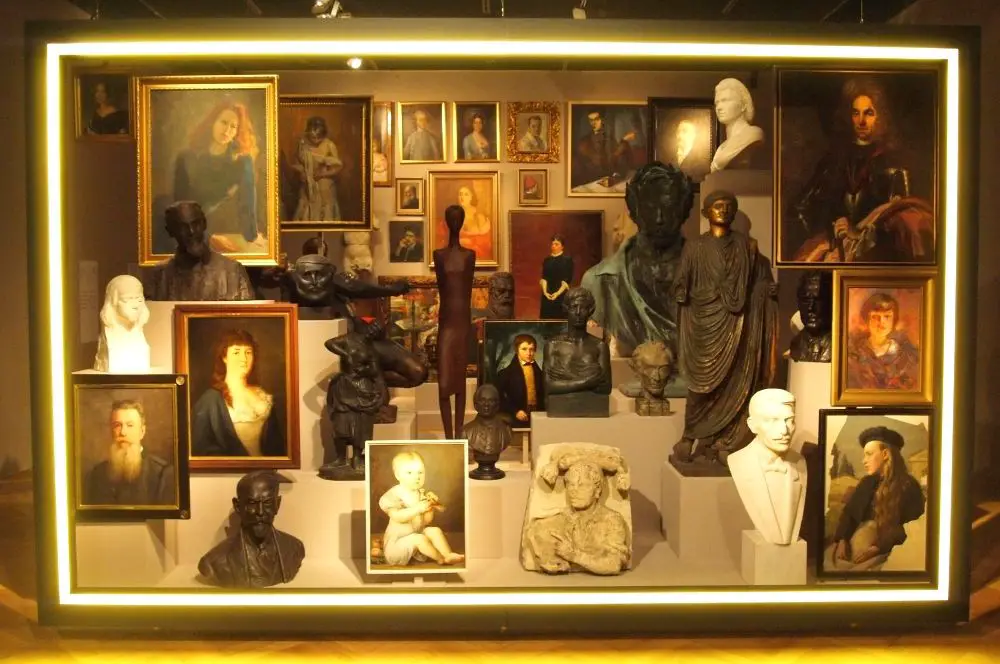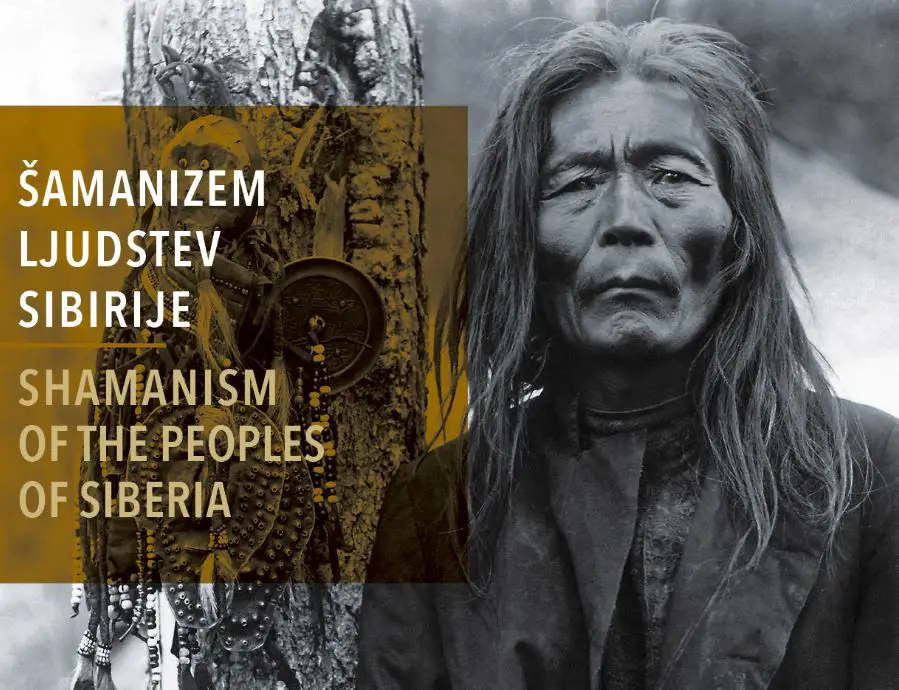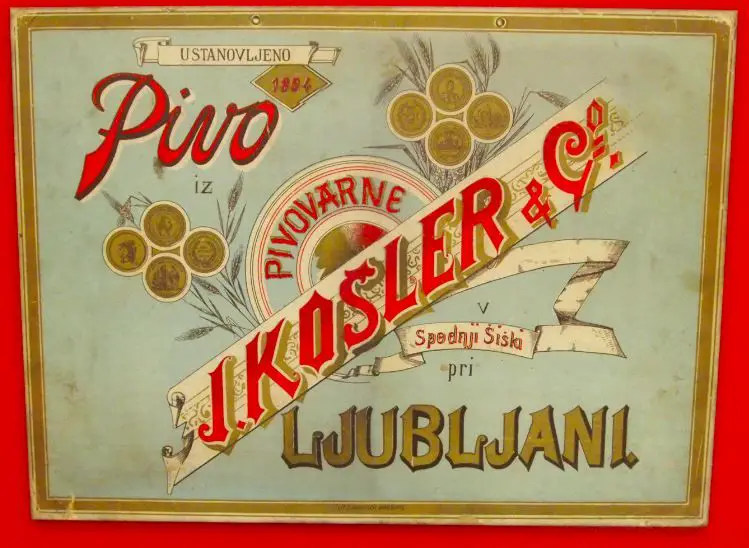Lifestyle
STA, 11 May 2019 - Following a push from the Traffic Safety Agency and a number of NGOs to lower the permitted alcohol level for drivers, Interior Minister Boštjan Poklukar expressed his disagreement with this proposal on Friday. He believes that the existing rules are good and that Slovenia should address alcohol-related issues as a broad social problem.
The minister was asked about his position on the proposal at the sidelines of a business conference in Portorož last night organised by the Chamber of Craft and Small Business (OZS), which has previously expressed opposition to the proposal.
The OZS believes that the initiative would damage the country's tourism industry and worsen the situation of hospitality businesses, already aggravated by several restrictive acts, including the new ban on trans fats and the tobacco act.
Related: Slovenia Launches Project to Reduce Drinking, Consumption Highest in EU
The alcohol limit for drivers in Slovenia is 0.05% of alcohol per litre of exhaled air, while the agency wants it to be reduced to 0.02%.
The proposal has been backed by a number of NGOs, many of which see it as the first step to gradually lowering it to 0.00%.
"Problems related to alcohol are not only limited to the roads. This is a general social problem that requires serious conversation. But I believe that current legislation is not bad," said Poklukar.
"Let's think whether this change is really necessary. I'm for 0.05%," he added, according to a press release released by his ministry today.
He also said that for the first time ever the number of road casualties dropped to below 100 last year.
STA, 8 May 2019 - Druga Godba, a festival of world music, will kick off in Ljubljana on 21 May and run until 25 May, when it will move to Maribor too. The event will feature 16 concerts of various music genres performers from eleven countries, including the acclaimed US experimental guitarist and composer Yonatan Gat and popular Ukrainian folk quartet DakhaBrakha.
Visitors will also be able to enjoy the beats of the London-based Afrobeat band Kokoroko or groove to the sounds of the leading Polish jazz musician Maciej Obara.
The 35th international festival will also see a return of the South African performance art ensemble The Brother Moves On, which will perform with the Slovenian pianist Bowrain.
Upon Druga Godba's initiative, the Helsinki-based futuristic jazz band Mopo will share the stage with Finland's saxophone star Jimi Tenor.
Another highlight will be a performance of the Brazilian band Liniker e os Caramelows and its charismatic lead singer Liniker, getting visitors moving with their funky soul Afro-Brazilian beats.
The Ljubljana-based events will either take place at Kino Šiška, the Cankarjev Dom arts centre or at AKC Metelkova.
The festival will move to Slovenia's second largest city on 25 May. The programme there includes a number of events in Maribor's former minorite church and the city puppet theatre's auditorium, such as a performance of the traditional Polish band Sutari, the Slovenian group Bakalina Velika and the South-African indigenous genre band BCUC.
Having bought the tickets for the Maribor-based events, the visitors from Ljubljana will be also entitled to a free return ticket to Maribor.
Druga Godba provides an opportunity to experience the fusion of traditional folk and contemporary music, cross-genre productions, aspiring as well as established musicians.
"Druga Godba is designed to inspire curiosity, broaden horizons, urge people to go listen to unfamiliar music acts. That has always been our aim and that remains the case this year," said the head of the festival's programme Bogdan Benigar.
The English website for the festival is here, while you can also follow it on Facebook
https://drugagodba.si/en/jazz-connective/
https://www.facebook.com/druga.godba.3
STA, 10 May 2019 - Novo Mesto, an idyllic town in the south-east, has joined an ever longer list of places in Slovenia closing their centres to traffic. Following nearly two years of renovation that revealed numerous archaeological artefacts, the Main Square was reopened in a ribbon-cutting ceremony on Friday.
Ahead of the ceremony, Environment and Spatial Planning Minister Simon Zajc said that the country would see more similar projects in the future. These will give "towns a new and more beautiful image and inspire a new way of life".
He praised the new traffic regime, which only allows pedestrians and bicyclers to the Main Square, while cars and other vehicles will only be permitted during limited delivery periods.
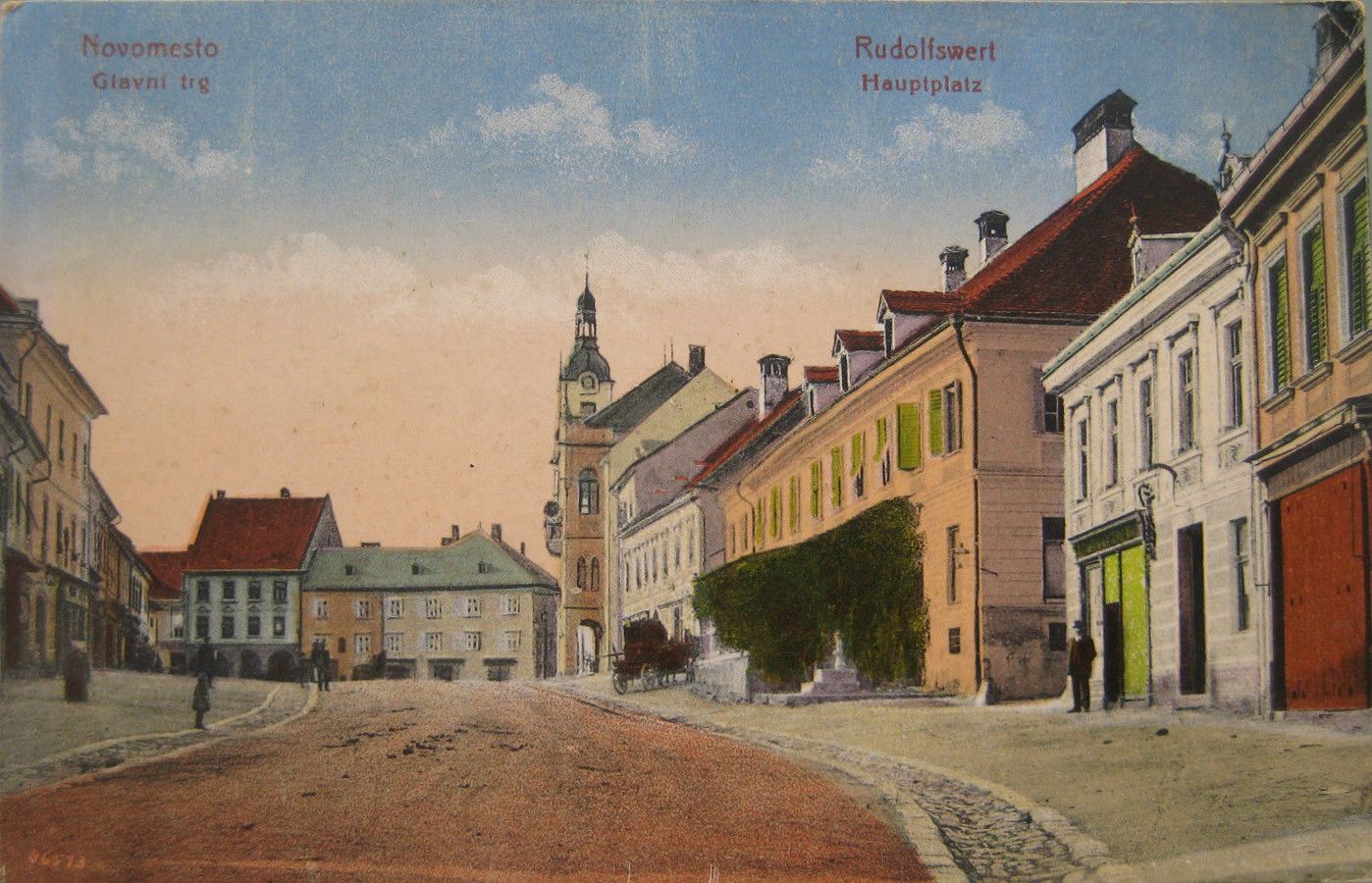
Back to the future. Postcard of the square in 1919. Source: Wikipedia, public domain
The renovation cost nearly EUR 7 million, with EUR 4.6 million coming from the EU cohesion funds.
A month ago, the Novo Mesto-based Dolenjska Museum opened an exhibition dedicated to the archaeological finds uncovered during renovation works.
The excavations that preceded the renovation works found proof of settlement in the Novo Mesto city centre dating back as far as prehistory.
Archaeologists found ceramics and the remnants of a road from prehistoric times. Cobble stones from the 17th and 18th centuries were uncovered, as well as remnants of a paved road from the Roman era.
The excavations also produced four Celtic and Roman coins, amphora fragments, Roman building remains, as well as several bronze fibulea from the 2nd and 1st centuries B.C.
Keep up with the daily news in Slovenia by checking the morning headlines here
This summary of the week ahead is provided by the STA:
MONDAY, 13 May
LJUBLJANA - The National Assembly will debate amendments to the real estate records act and the opposition's allegations about political pressure on the judiciary.
BRUSSELS, Belgium - Foreign Minister Miro Cerar will attend a session of the EU's Foreign Affairs Council. He will also attend an event marking the 10th anniversary of the Eastern Partnership.
BEIJING/HANGZHOU, China - Agriculture Ministry State Secretary Jože Podgoršek will attend a meeting of farm ministers of the 16+1 initiative and a forum on agricultural and trade cooperation between China and Central and Eastern Europe.
LJUBLJANA - President Borut Pahor will receive members of the first Slovenian expedition to Mount Everest upon the 40th anniversary of the feat.
LJUBLJANA - The Association of Journalists and Commentators will host a panel on changes to the umbrella media law.
LJUBLJANA - The Charm of Wood, an exhibition dedicated to wood design, will open at the Cankarjev Dom; until 18 May.
LJUBLJANA - The start of the National Volunteering Week; until 19 May.
TUESDAY, 14 May
LJUBLJANA - Prince Edward, Earl of Wessex will start a two-day visit to Slovenia at the invitation of President Borut Pahor.
LJUBLJANA - The parliamentary Home Policy Committee will debate Schengen border protection at the request of the Democrats (SDS).
CERKLJE OB KRKI - Slovenian Armed Forces Day will be celebrated with a display of Slovenian military gear, with keynotes by Defence Minister Karl Erjavec and President Borut Pahor.
BRUSSELS, Belgium - Agriculture Minister Aleksandra Pivec will attend a session of the EU's Agriculture and Fisheries Council while Defence Ministry State Secretary Miloš Bizjak will be on hand for a session of the Foreign Affair Council.
KLAGENFURT, Austria - National Council President Alojz Kovšca will visit Carinthia to meet members of the Slovenian minority and Governor Peter Kaiser.
LJUBLJANA - AJPES, the agency for public legal records, will present cumulative data on the performance of companies in 2018.
TEL AVIV, Israel - Slovenian Eurovision entrants Zala Kralj and Gašper Šantl will perform in the first semi-final of the song competition.
WEDNESDAY, 15 May
SKOPJE, North Macedonia - Agriculture Minister Aleksandra Pivec will start a two-day visit to North Macedonia.
LJUBLJANA - The Agriculture Committee will debate allegedly questionable financing of a campaign for the promotion of Slovenian food.
CELJE - Chemical company Cinkarna Celje will release its Q1 financials.
LUXEMBOURG, Luxembourg - The board of directors of the European Investment Bank (EIB) will decide on the planned EUR 250 million loan for the Koper-Divača rail project.
LJUBLJANA - Slovenian Book Days; until 18 May.
LJUBLJANA - Laibach will perform songs from the last album, The Sound of Music, at Cankarjev Dom.
THURSDAY, 16 May
LJUBLJANA - The parliamentary Defence Committee will debate the status of the Poček military training grounds.
LJUBLJANA - The parliamentary Finance Committee will debate the Left's proposal for a tax on digital services.
LJUBLJANA - The parliamentary Commission for Slovenians Abroad will debate direct representation of the Slovenian diaspora in the National Assembly.
LJUBLJANA - Weekly government session.
BRUSSELS, Belgium - Finance Minister Andrej Bertoncelj will take part in a Eurogroup session.
HELSINKI, Finland - Foreign Minister Miro Cerar will take part in a two-day session of the Council of Europe (CoE) foreign ministers.
BRUSSELS, Belgium - Foreign Ministry State Secretary Simona Leskovar will attend a meeting of the EU ministers in charge of development.
LJUBLJANA - Public broadcaster TV Slovenija will host two EU election debates, respectively with the candidates of parliamentary and non-parliamentary parties.
LJUBLJANA - A debate on digitalisation of cultural heritage organised by several museums and ministries.
LJUBLJANA - Insurer Zavarovalnica Triglav is expected to release preliminary Q1 results.
LJUBLJANA - Insurer Sava Re is expected to release preliminary Q1 results.
MARIBOR - International circular economy conference Circular Change; until 17 May.
PODČETRTEK - Slovenia Incoming Workshop, the biggest event for tour organisers in Slovenia; until 18 May.
FRIDAY, 17 May
LJUBLJANA - The National Assembly will hold an emergency session to debate the Democrats (SDS) proposal to exclude healthcare and the army from the single public sector pay system.
LJUBLJANA - Energy group Petrol is expected to release preliminary Q1 results.
SATURDAY, 18 May
RAVNE NA KOROŠKEM - Slovenia will mark World Bee Day with an event featuring exhibitions, workshops and speeches by officials.
SUNDAY, 19 May
LJUBLJANA - Parliamentary Speaker Dejan Židan will receive his Swiss counterpart Marina Carobbio Guscetti for a three-day official visit.
If you're not in town for the week of this guide (13 - 19 May, 2019) then you can see all the editions here, and if there's event you want to promote in a future edition of What's on in Ljubljana please get in touch with me at flanner(at)total-slovenia-news.com or try and find me on Facebook. As ever, links to venues are after the following selections…
The Castle’s the city’s main attraction, and Saturday and Sunday see the annual Castle Days, with a medieval camp, workshops, mock fights, free tours and more, including free entrance to the Tower. You can read about it here.
Starting Thursday and running until mid-June is Svetlobna gverila / Lighting Guerrilla. This is a free festibal of light-based art at various locations around town, each opening at different dates. The first takes place at Galerija Vžigalica and other spots nearby Križanke / French Revolution Square. This is usually very beautiful, but obviously best enjoyed after dark.
Pop music highlights over the next seven days include Laibach playing The Sound of Music at Cankerjev dom on Wednesday (15 May), Morcheeba at Kino Šiška on Thursday and Benjamin Clementine at the same venue on Friday. Saturday the biggest name in town in Tom Jones, playing Ljubljana for the first – and perhaps the last – time, so head to Arena Stožice if you want to hear the all the hits and perhaps a story or two about Elvis.
K4 15 years from 4ka on Vimeo.
With regard to clubs, K4 is celebrating its 30th anniversary this year, with a documentarmy made for its 15th shown above. The big day is really May 25, but the 30K4 Festival begins Friday, 17 May and runs until the 31st.
Sports meets acrobatics with the Dunking Devils live show, bringing basketball and trampoline to Hala Tivoli on Friday and Saturday, 19:00.
Friday also sees the annual Maturantska Parada, an “almost graduated” dance routine / prelude to a party by local high school students. This will start at 12 noon on Slovenska cesta, with an after party at the Next Level Festival.
The Festival Lezbična četrt, or the Lesbian Quarter Festival, runs until 18 May and has lots of different events around town, from talks to workshops, DJ sets to dance performances, guided tours to film screenings. The Facebook page has all the details, in Slovene and English.
In town and want to follow the news? Check out our regular morning headlines for Slovenia here.
- Cinemas and films
- Clubbing
- Live music
- Theatre and dance
- Harm reduction and drug testing
- Things to do with children
- LGBT+ Ljubljana
- Ljubljana Castle
- Museums and galleries
- Other things to do in Ljubljana
- Daytrips
- Getting around & miscellaneous
Cinemas and films
You can read about all the cinemas in town here, while a selection of what’s playing this week is below, and note that kids' movies tend to be shown in dubbed versions, while non-English language movies for older viewers will have Slovenian subtitles.Parents should also pay attention to Kinobalon, which is Kinodvor's regular weekend series of film screenings and events for children, from babies on up, with special parent/child events, "first time in a cinema" screenings, and babysitting. Learn more about it here, and see the current schedule here.
Kinodvor –This is an arts cinema, not far from the train station, that shows new features as well as hosting the occassional festival.
Kinoteka – And not far from Kinodvor you can find this revival cinema, which shows art house classics along with some deep dives in the archives.
Kino Bežigrad - A relatively small theatre, but one which usually has the biggest of the new releases.
Kolosej -The multiplex out at BTC City Mall shows all the big movies, with well over a dozen titles on the schedule, although note that there are far more movies than screens, so some of the older ones mayonly be playing once or twice a week.
Komuna – The cinema in a basement behind Nama department store shows two or three different features a week, usually including the biggest titles.
Clubbing
Compared to some European capitals it can seem that nightlife in Ljubljana ends rather early, especially along the river, but there are still bars that stay open late and clubs were you can dance until dawn, and perhaps the best place to stumble across something interesting is the legendary Metelkova. Be aware it's a grungy kind of place and not for all tastes, but also that there's considerable variety to found within the various clubs there, from death metal to electropop, gay cabaret to art noise. You can read "the rules" of the place here. And if you're curious about how the place started then read our story, and look at some pictures, about last year's 25th anniversary.
Božidar - DJ events aren't too common here, but when they happen they often have a big name.
Channel Zero – DJs shows here include regular dub nights as well as electronic music.
Gala Hala – Another Metelkova venue, you can sometimes hear bhangra and Bollywood here, but more often funk, hip hop, breakbeat and so on.
Klub Cirkus – The more commercial end of clubland, and a venue that aims to serve the student party scene. Expect house, anthems, and bangers.
Klub K4 – The home of techno, old and new, along with various other electronic genres,
Koncertna Dvorana Rog– There are irregular DJ sets at this underground (not literally) venue at the far end of Trubarjeva cesta, and they range from techno to goa to drum'n'bass.
Orto Bar– 80s and 90s throwback nights can often be found here, along with rock-based DJ sets.
Live music
Balassi Institute – Free Hungarian music, when available, from the Hungarian cultural institute just a short walk downriver from Dragon Bridge.
Cankerjev dom – The main arts venue in the country hosts classical, opera jazz, folk and occassinally pop.
Cvetličarna – Regional pop and rock concerts can be found here.
Channel Zero – This Metelkova venue sees live shows from punk and rock bands, as well as others.
Gala Hala – Another Metelkova venue with indie bands of various styles.
Kino Šiška – One of the top live venues in the city, with a varied programme that include indie, rock, pop, experimental, hip hop, and so on.
Klub Gromka – Live music is often metal, from sludge to stoner, death to thrash, while punk bands also appear, as do others.
Križanke – The venue that hosts the Ljubljana Festival often has classical music, and some rock, in the open air.
Ljubljana Castle – Jazz, funk and pop every Friday night.
Orto Bar– The home of live rock, metal, punk and other guitar-based genres.
Pinelina dnevna soba – LIve music is rare here, but it does happen.
Slovenska filharmonija– Classical music in the centre of town.
SNG Opera and Ballet - As the name suggests, here you'll find the best of opera and ballet in the country.
Španski borci - While dance is more common here, they also have some contemporary and experimental music shows.
Theatre and dance
Cankerjev dom- The main arts venue in the country always has something of interest going on.
Gledališče IGLU - IGLU Theatre – Saturday night this group is usually putting on an English improv show somewhere in town, but it’s generally promoted after this is written, so check the Facebook before putting on your shoes.
Kino Šiška – One of the top live venues in the city also hosts some dance performance, often of the more experimental variety.
Mini Teater Ljubljana –The English schedule of varied performances, for adults and children, for the month is here.
Ljubljana Puppet Theatre - Puppetry has a long and noble tradition in Slovenia, and you can see performances for children and adults (including non-puppet shows) drawing from the Theatre's rich repetoire as well as new productons.
SNG Opera and Ballet - As the name suggests, here you'll find the best of opera and ballet in the country.
Španski borci - The home ofcontemporary dance(and the EnKnapGroup) in Slovenia.
Pocket Teater Studio– There are regular flamenco evenings at perhaps the smallest venue town, but note that the number of seats is very limited, and thus you should make a reservation via This email address is being protected from spambots. You need JavaScript enabled to view it. or 070 325 522.
Harm reduction and drug testing
Drogart is an organization that aims to minimise harm on the party scene, and offers drug-testing services and reports on their webpage. It’s in Slovene, but you can Google translate it or work things out yourself, and our story on the group is here.You can find the latest warnings on fake drugs and high strength pills and powders (in Slovene) here. However, be aware that all the usual drugs are illegal in Slovenia.CBD is legal, though, and our retailer of choice can be found on Trubarjeva cesta - read more about Sena Flora here.
Things to do with children
You can find our Top 12 list of things to do with kids in Ljubljana here. If want to read more about the philosophy behind the wonderful House of Experiments look here, while our trip to the Museum of Illusions is documented here, and there’s always riverside walks, pizza and ice cream. With regard to the latter, take a look at our guide to six places that serve good ice cream in winter, and thus are serious about the dessert.
Mini Teater Ljubljana – The season sees a lot of puppet performances for children, in Slovene, at this theatre not far from Križanke. The English schedule for the month is here.
Ljubljana Puppet Theatre - The puppet theatre near the Central Market and next to the Castle funicular has a full programme or shows, for children and adults, with the schedule here.
LGBT+ Ljubljana
If you want to learn more about Ljubljana Pride, then take a look at our interview with its president here. If you're looking for more general links on "gay Slovenia", including a history of the scene and various projects, then you can find that here, while our stories about the community can be found here.
Klub Monokel – Thislesbian barin Metelkova is open every Friday, although sometimes there are other events
Klub Tiffany –And the gay bar next door is also open on Fridays, while every Monday until June 2019 there'stangoat 18:00. Other things coulds also be planned, so click on the name to find out.
Pritličje – This seems to be the only "always open" LGBT-friendly cafe / bar / events space in town, and perhaps the country, so it's a good thing it's such a good one, open from morning to night, and with fliers and posters letting you know what's happening outside the narrow confines of, say, a general interest online what's on... guide.
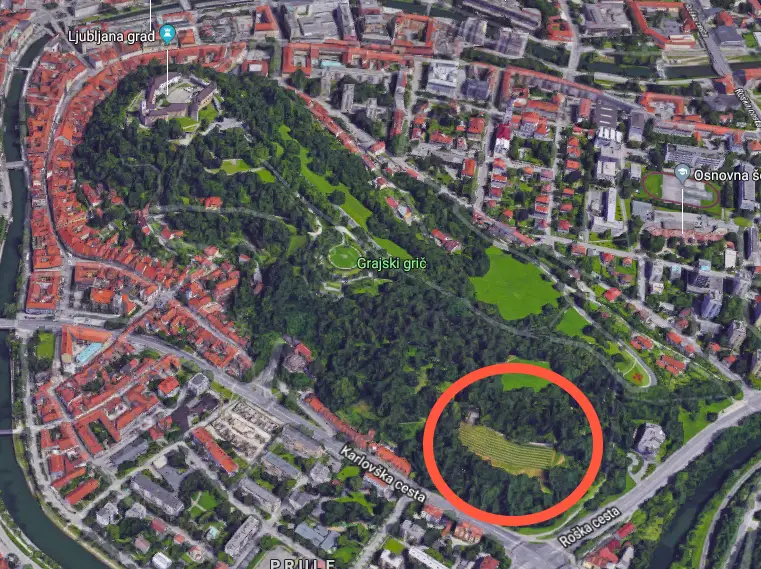
Screenshot from Google Maps, showing the location of the Castle vineyard
Ljubljana Castle
The city’s main attraction is said to be the top tourist draw in the country overall, and to my mind it earns a spot near the top just for the history and views. But beyond that the current owners, the City of Ljubljana, have laid out a varied, interesting and enjoyable programme of events, one that rewards regular revisits.
I try and get up there every Saturday morning to clear my head and move my feet on the trails, and never tire of that end of the hill. At the other end, where the Castle sits, there’s a lot more than fresh air on offer. There are guided tours, restaurants, a café, Castle museum, puppet museum, a Watchtower you can climb to the highest point in the city, art shows, dances, live music, movies under the stars, festival days and more – enough to reward multiple trips up the hill through the year. All of these activities and events can be found on the Castle website, while on TSN you can see “25 things to know about Ljubljana Castle” here, and “Ten Ways to Enjoy Ljubljana Castle” here.
Museums and galleries
Most public galleries and museums are closed on Mondays, although not the National Museum, and - as noted at the start
Cankerjev dom –The 13th Slovenian Biennial of Illustration is here until May 19th, while a free to see show called Subterranean Worlds, showing cave photography, runs until June 16th.
Plečnik's desk. Photo: JL Flanner
Plečnik’s House is worth a visit if you want to learn more about the architect who gave Ljubljana much of its character, and it's also in a really nice part of town, Trnovo, just a short walk or cycle upriver. Read about our guided tour here.
Balassi Institute – The Hungarian culture centre hasInterlacement – exhibition of Éva Farkasvölgyi and Žiga Okorn, showing tapestries and paintings on until June 14th.Free to enter, this venue is next to a Spar and Hofer, and not far from Dragon Bridge, and always has something interesting going on. Learn more here.
City Museum – The Museum in French Revolution Square an interesting permanent exhibition on the history of Ljubljana, from prehistoric times to the present day, with many artefacts, models and so on that bring the story alive.You can read about my visit here.
The Faces of Ljubljana in the City Museum. Photo: JL Flanner
International Centre of Graphic Arts – Starting March 22 and running until May 19 is Photographic Images and Matter: Japanese Prints of the 1970s and Japan, Yugoslavia and the Biennial of Graphic Arts: Documents of Collaboration. One of the images promoting the show is shown below.
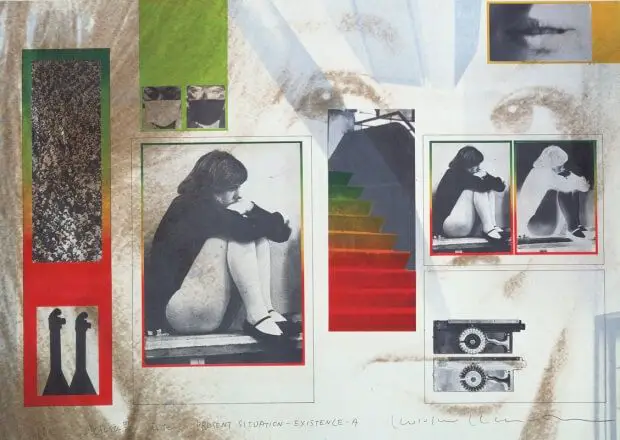
Kosuke Kimura: Present Situation – Existence A, colour and silkscreen, 1971.
MAO – The Museum of Architecture and Design has much of what you'd expect, along with some temporary shows and a good cafe. UntilMay 19 there's Tendencies: Architecture and Urban Planning in Celje, 1955–1985.
Moderna galerija – The main branch of this gallery, to be found near the entrance to Tivoli Park, has a good collection of modern art, as well a nice café in the basement. Opening Thursday, April 25th, 20:00, The Visual Arts in the Kingdom of Yugoslavia, 1929–1941, which then runs until September 15th 2019. This offers “an overview of painting, sculpture, printmaking, drawing, photography, and film from the time the king's dictatorship was set up (6 January 1929) to the beginning of World War II on Yugoslav soil (April 1941)” - you can read more about it here. The museum's Metelkova branch also has a big new show, runing until at least September 2019, an the art of the Non-Aligned Movement, with an example shown below.
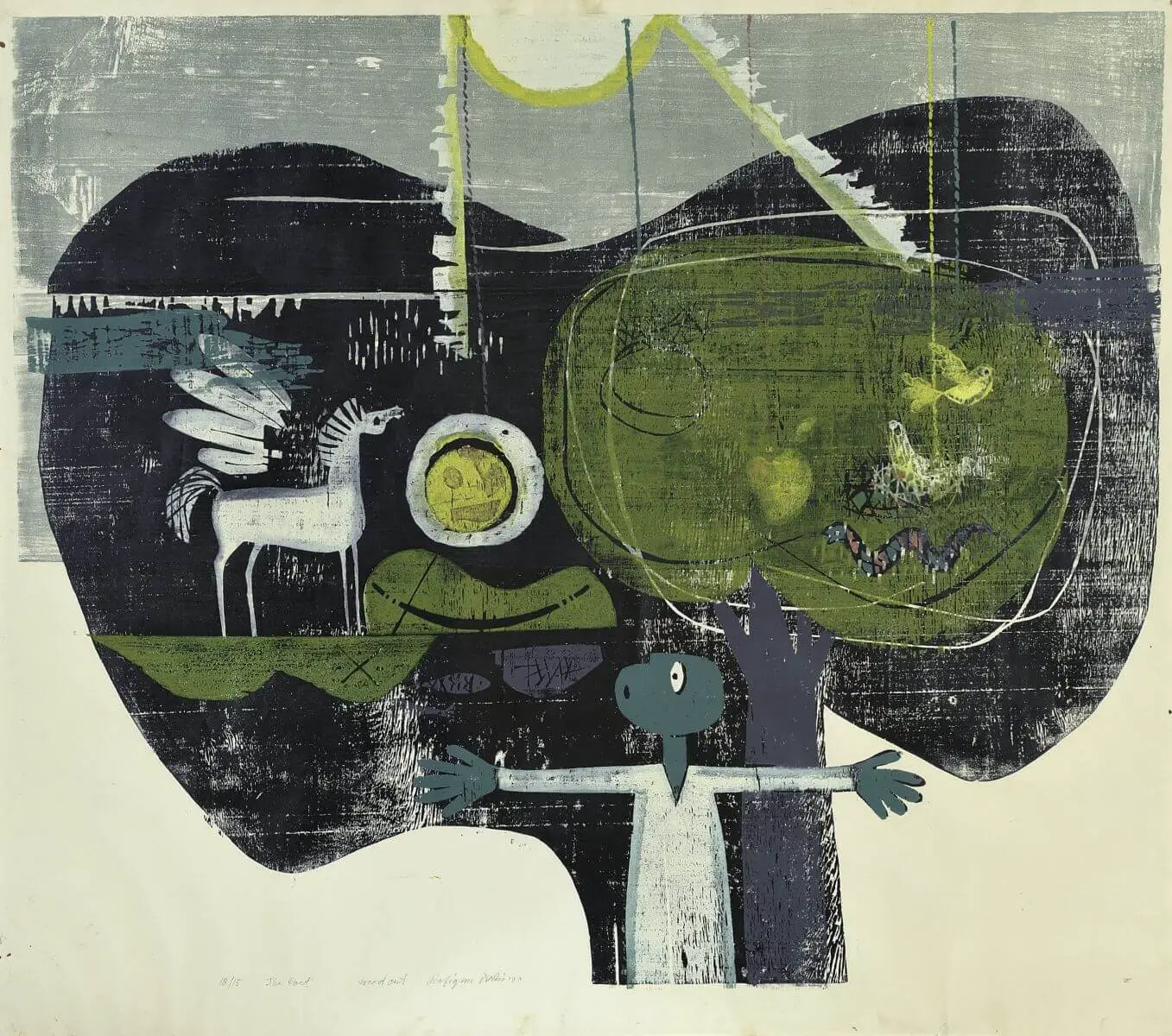
Rafikun Nabi: Poet, 1980, print, 96.5 x 110 cm. Courtesy of the Contemporary Art Center of Montenegro. On display at the Metelova branch of the Moderna galerija
National Gallery – The country’s main gallery has “the best” of what’s on offer from the Middle Ages to non-contemporary modern visual arts, and is in a great location for exploring other areas, just by Tivoli Park and opposite the main branch of the Moderna galerija. You can read about our visit to the room containing sacred art from the Middle Ages here.
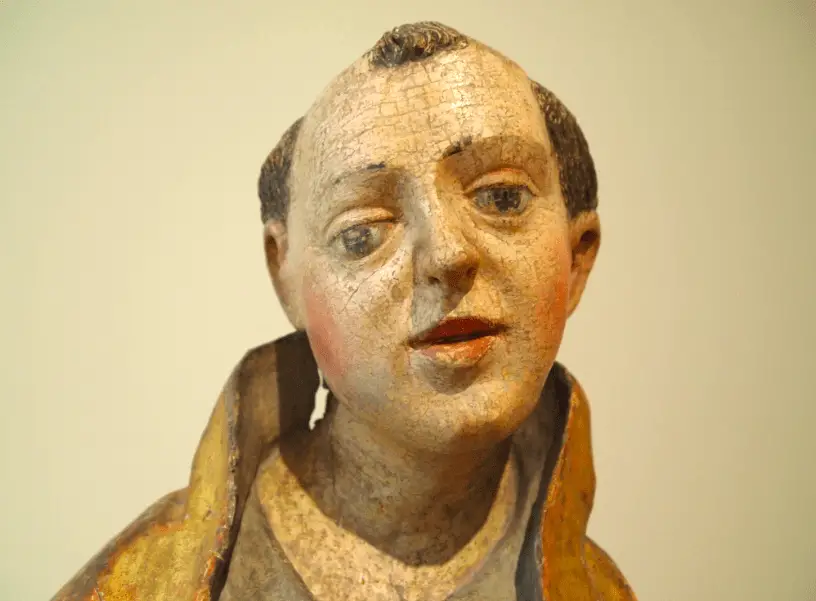
JL Flanner
The real Robba Fountain can be found in the entrance to the National Gallery - the one you see in the Old Town is a genuine fake, as seen below and reported here.
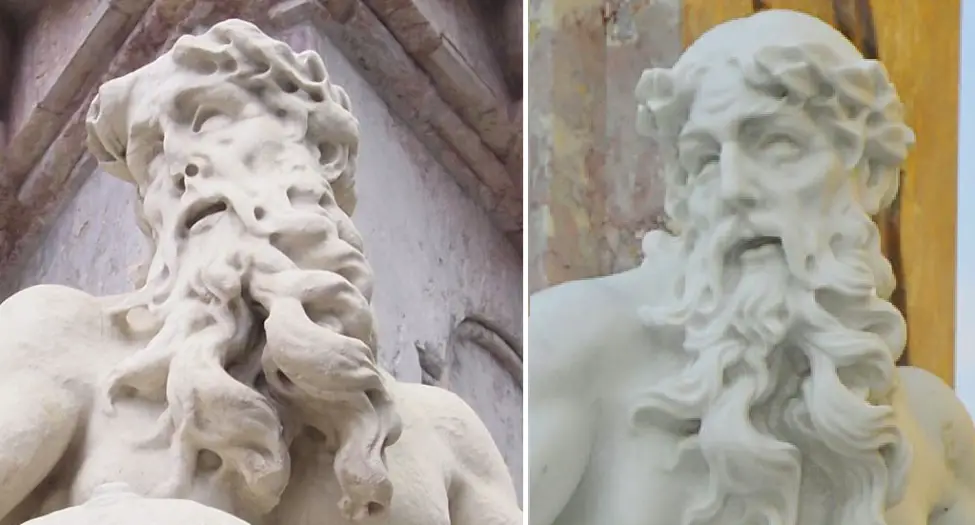
Photo: JL Flanner
National Museum of Slovenia – There’s plenty to see in the permanent collection here, from Roman times, Egypt and more. Meanwhile, the museum's Metelkova branch, located between one branch of the Moderna galerija and the Ethnographic Museum has some rooms on Church art, furniture and weapons, with the latter including more guns than you'll see anywhere else in town, and quite a thrill if coming from a nation where such objects are not household items.
Natural History Museum – On until the end of June 2019 is Our Little Big Sea, which takes a look at the oceans.
National Museum of Contemporary History - Tucked away in park Tivoli, in addition to his permanent collection will be showingIn Search Of Freedom: 1968-2018 until 16 August.
Slovene Ethnographic Museum – The museum currently has a temporary show on Bees and Beekeeping, on until June 16 2019, as well two permanent exhibitions. One of these is called Between Nature and Culture, and has a great collection of objects from Slovenia and around the world, well worth the trip up to the third floor to see it (as recounted here). From April 18 until October 19 (2019) you can also see a show calledShamanism of the Peoples of Siberia, from the Russian Museum of Ethnography, Saint Petersburg. The place is located near the newer branch of the Moderna galerija and Metelkova. You can read about this fascinating show here.
Union is "the Ljubljana beer", but now both it and Laško are owned by Heineken. There are many local brews on offer around town, though, if you want to explore IPAs, stouts, wheatbeers, sours and so on Photo: JL Flanner
Union Experience – The Ljubljana-based brewer has a museum showing the history of the company, with the ticket also including access to part of the factory and a few samples of the product. You can read about our visit here.
Volčji Potok Arboretum - Running until 3 November you can see a large collection of cacti here.
It's not a formal museum, but if you're interested in "Yugo-stalgia" then you'll enjoy a trip to Verba, a small, privately run space that's crammed with objects and pop culture items from the era, and is conveniently located at the start of one of the short walks to the castle. It's also a great place to take pictures, if you leave a donation, and you can read more about it here.
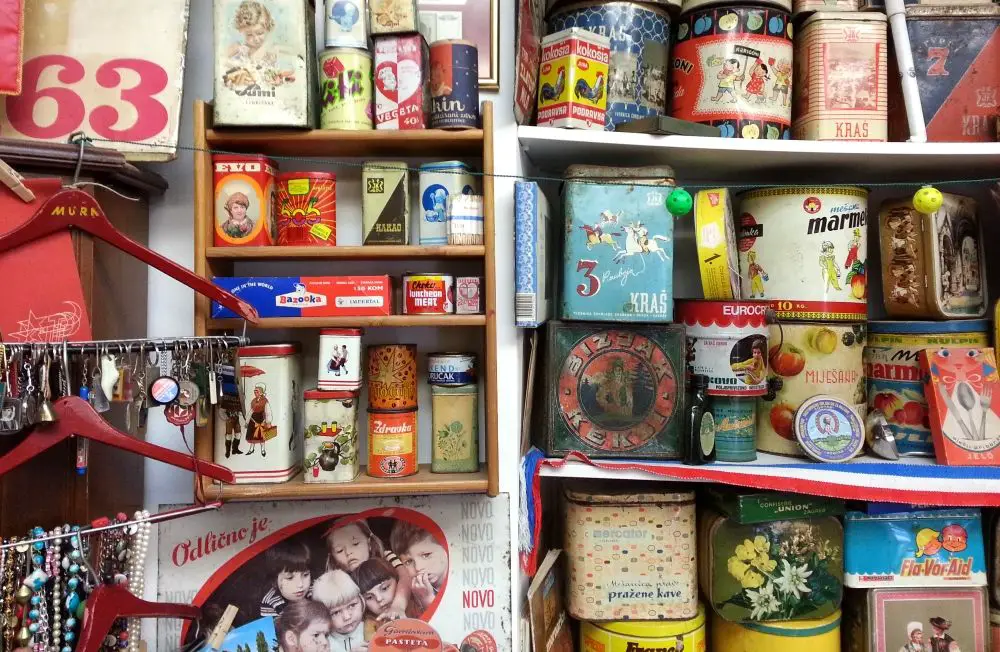
Verba. Photo: JL Flanner
Alternative Ljubljana isn't a museum or gallery, as such, but instead turns the city streets into a museum and gallery. Learn more about their tours of street art, history and LGBT Ljubljana here.
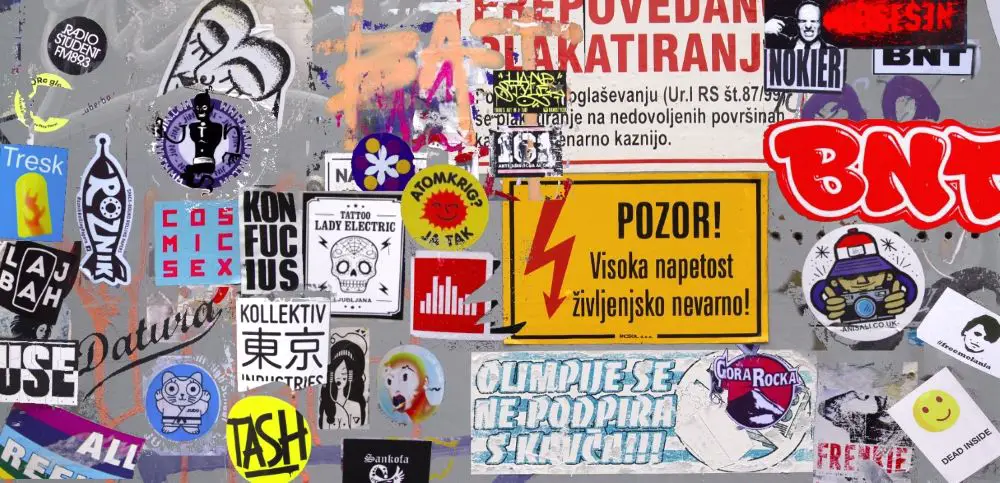
Photo: JL Flanner
Other things to do in Ljubljana
Learn more about Ljubljana with "25 things to know about Slovenia's green city of dragons", or take a look at our guide to spending from four to 48 hours here.
Open Kitchen brings market stalls selling food and drink from some of the best restaurants in town every Friday, from 11am to 11pm, in the square between the cathedral and the river - just follow your nose and the crowds. Read more about it here.
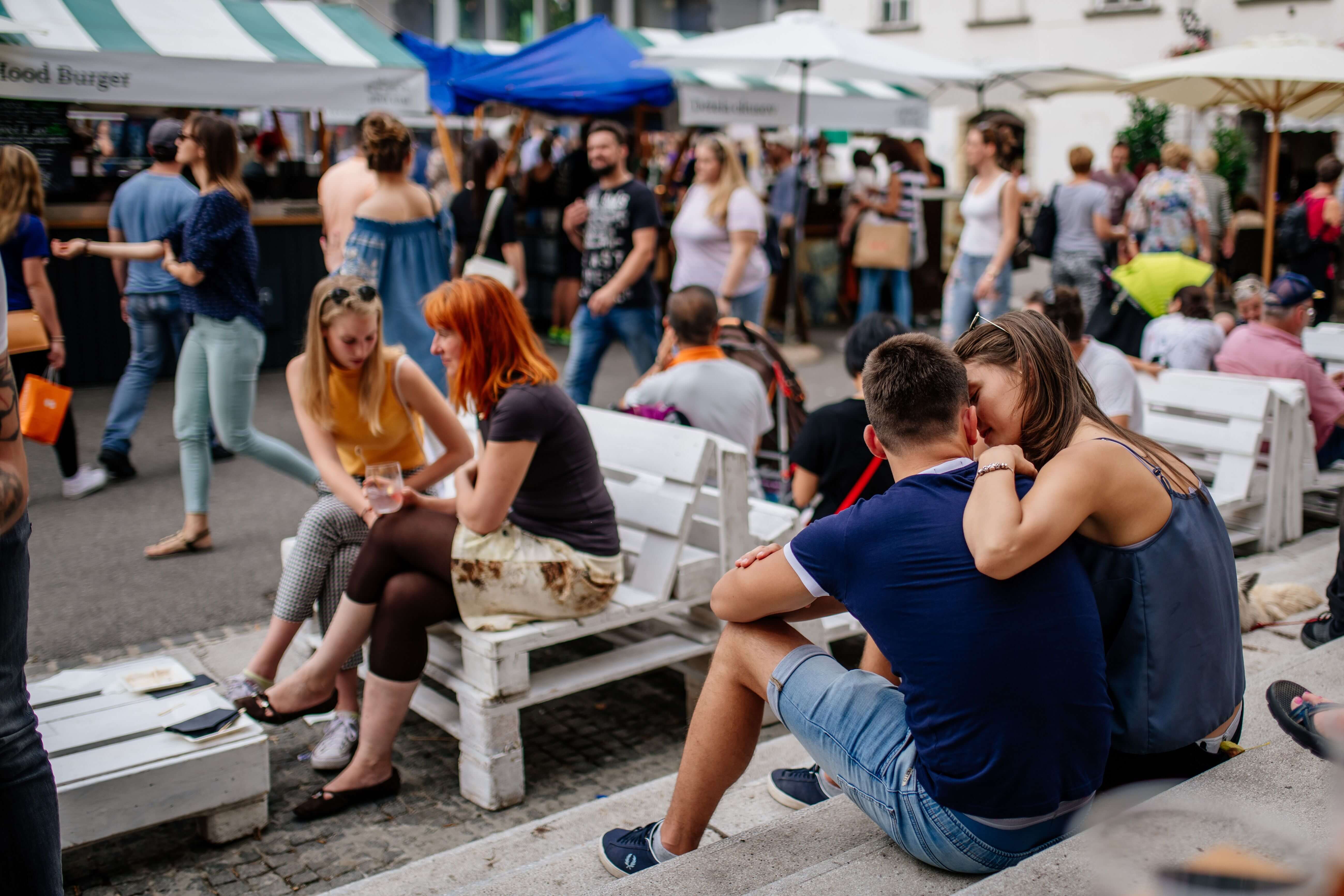
Photo: Open Kitchen
If you'd like to spend an evening painting with others, then take a look at Design with Wine, which organises painting parties on Trubarjeva cesta,
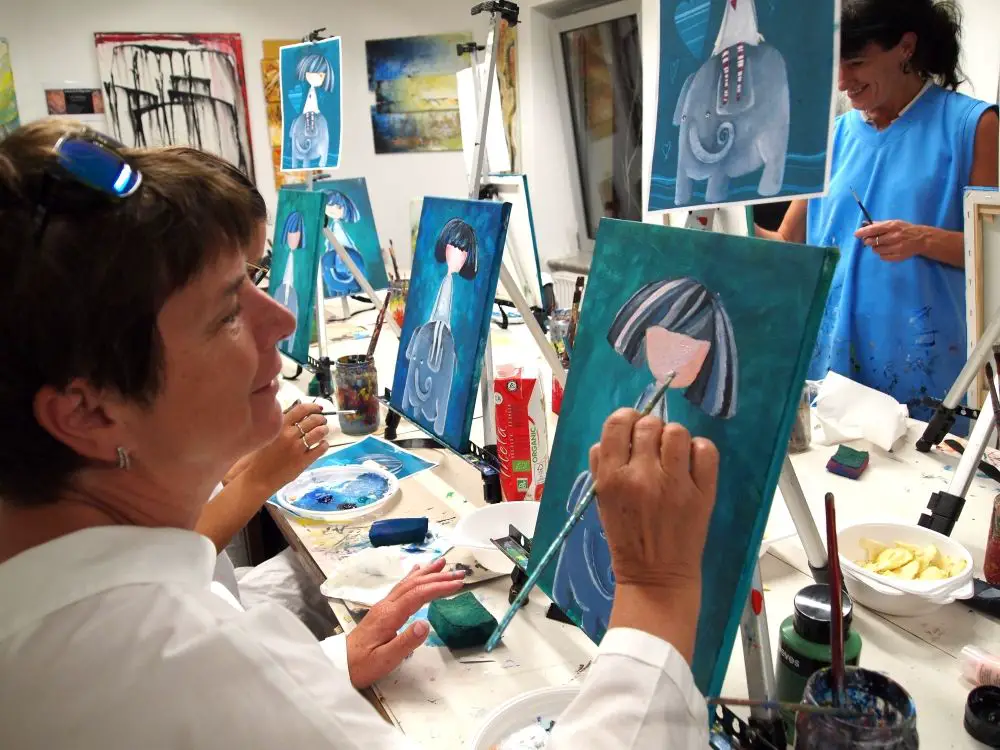
If you want to see some antiques, then check out the wonderful Antika Carniola, as discussed here. The man behind it, Jaka Prijatelj, has a fine eye for life on this street, as you can see on his Facebook account.
Photo: JL Flanner
If you’re in town and want to go jogging or walking in nature, why not take another look at the Castle, with a brief guide to the trails here. If you want something bigger, head to Tivoli Park.
And if you're bored with the Old Town, why not take a walk, cycle or boat ride to nearby Špica and enjoy the riverside life. Learn more about that here.
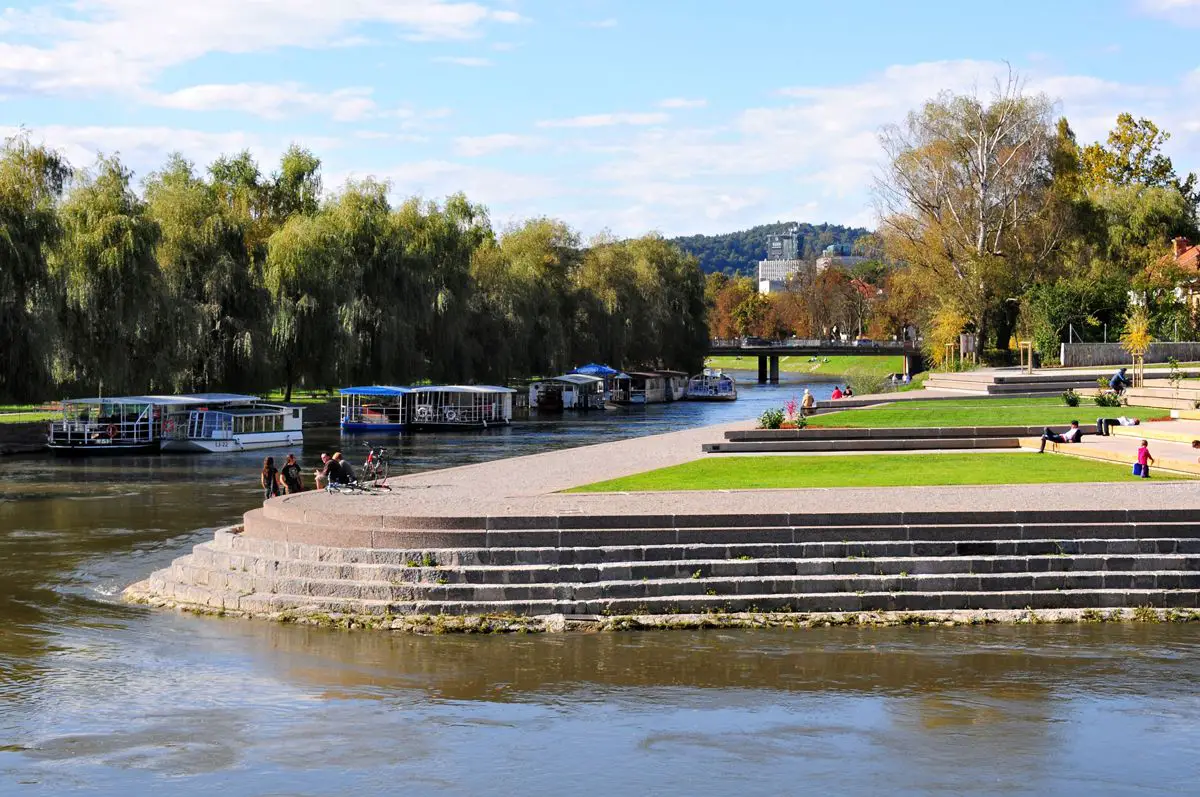
visitljubjana.si
![]()
maxpixel.net, public domain
Want to stretch and breath? Then check out our list of drop-in yoga classes for tourists, visitors and the uncommitted. If you're heading to the coast, check out our interview with a yoga teacher who offers breakfast sessions there, while if you're staying in town (or nearby) and want to try some "family yoga" then you can learn more about that here and maybe get your kids to calm down a moment or two.
Prefer to have someone else stretch you? The check out the totally legit massages you can get from Sense Wellness - either in one of their spas or in you home, office or hotel. (And - to repeat - these are legit and non-sexual in nature)
There are some golf courses near Ljubljana, but even ones further away are not far, as seen in our list of all the golf courses in Slovenia.
![]()
Photo: maxpixel.net, public domain
Daytrips
Most of Slovenia is only a few hours from Ljubljana, and you can easily visit Lake Bled, Lipica Stud Farm, Postojna Cave, Predjama Castle, the coast and other locations, while if you'd like to take a photo of from that bench in Bled, then you can learn how to get there here. If you’re looking for something more ambitious, then check out our recent guide to the 17 members of the Association of Historical Towns of Slovenia. We've also written guides on spending from four to 48 hours in Bled and Piran.
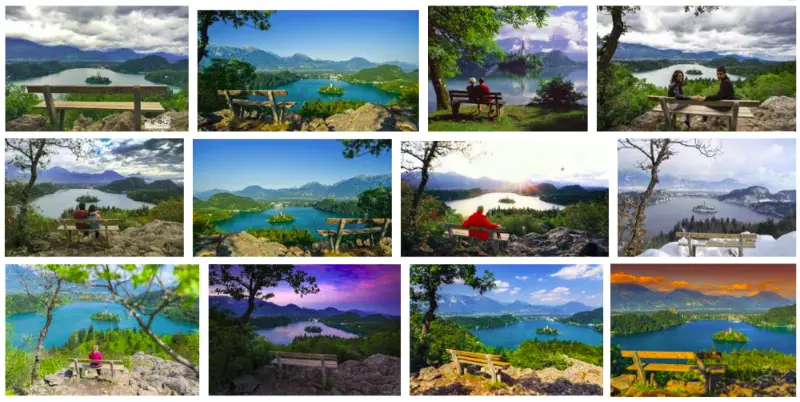
Photo: Google Image Search
Getting around & miscellaneous
If you want to get a Ljubljana Tourist Card, which gives you travel on the city buses and entry to a lot of attractions, then you can read more about that here, and if you want to use the bike share system, as useful for visitors as it is for residents, then you can learn more by clicking this. Visitors with reduced mobility will be pleased to find that downtown Ljubljana is generally rated as good with regard to accessibility, and that there’s a free, city-sponsored app called Ljubljana by Wheelchair highlighting cafés, attractions and so on with ramps, disabled bathrooms and Eurokey facilities, which you can read about and download here. Manual wheelchair users can also borrow, for free, an attachment that will motorise their equipment, as reported here.
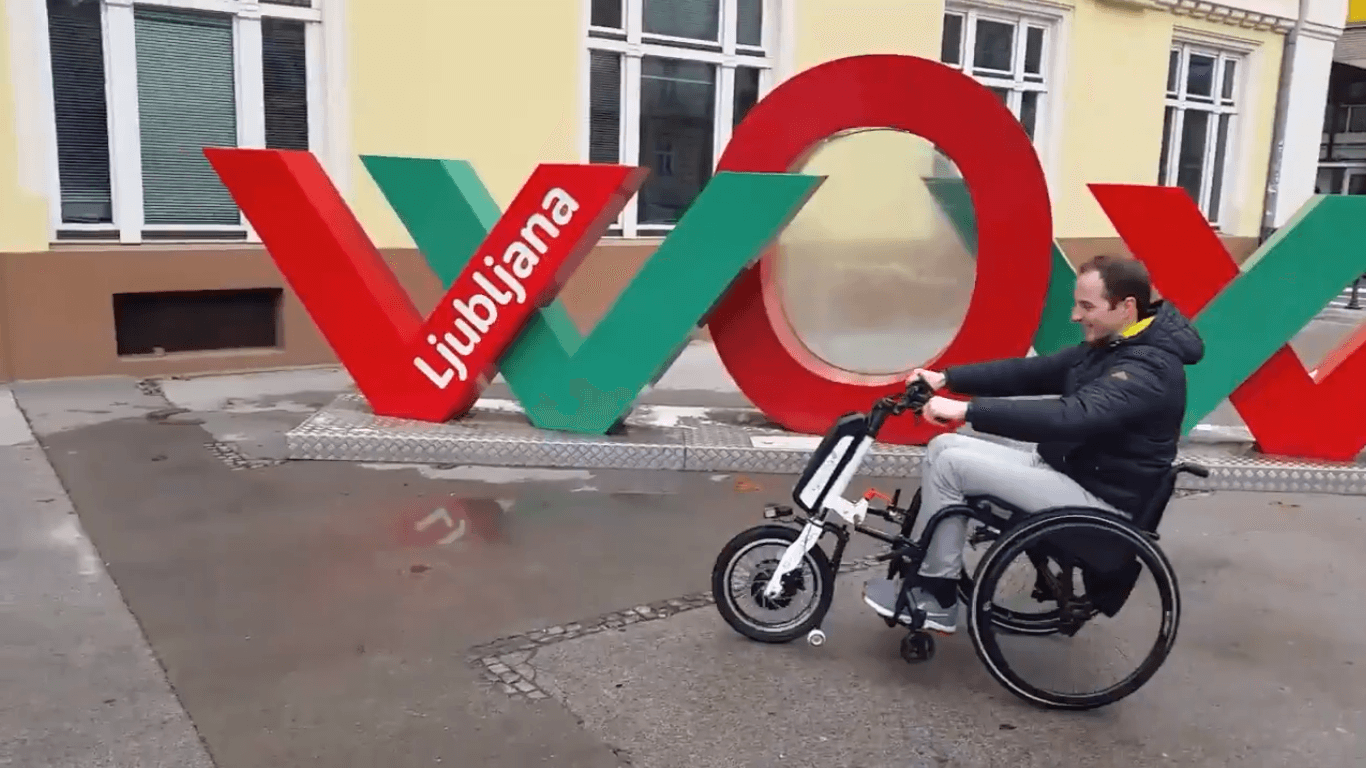
Screenshot from a Twitter video
If you’re driving into town and don’t know where to part, our guide to how to park in Ljubljana is here.
There aren't many places to eat after midnight, and most of them are by the train station, as reported here.
Want / need cigarettes but the stores have closed? Here's an incomplete list of bars downtown that will satisfy your craving for the demon weed. While if you’re having trouble with the ATMs then here’s a guide to the Slovene you’ll see on screen. If you get a hangover then find out where to get paracetamol (and prescription drugs) in Ljubljana here, while details on emergency birth control can be found here.
Ljubljana is a small and relatively safe city, but if need to contact the police then there’s a special number for foreigners, and that’s 113.
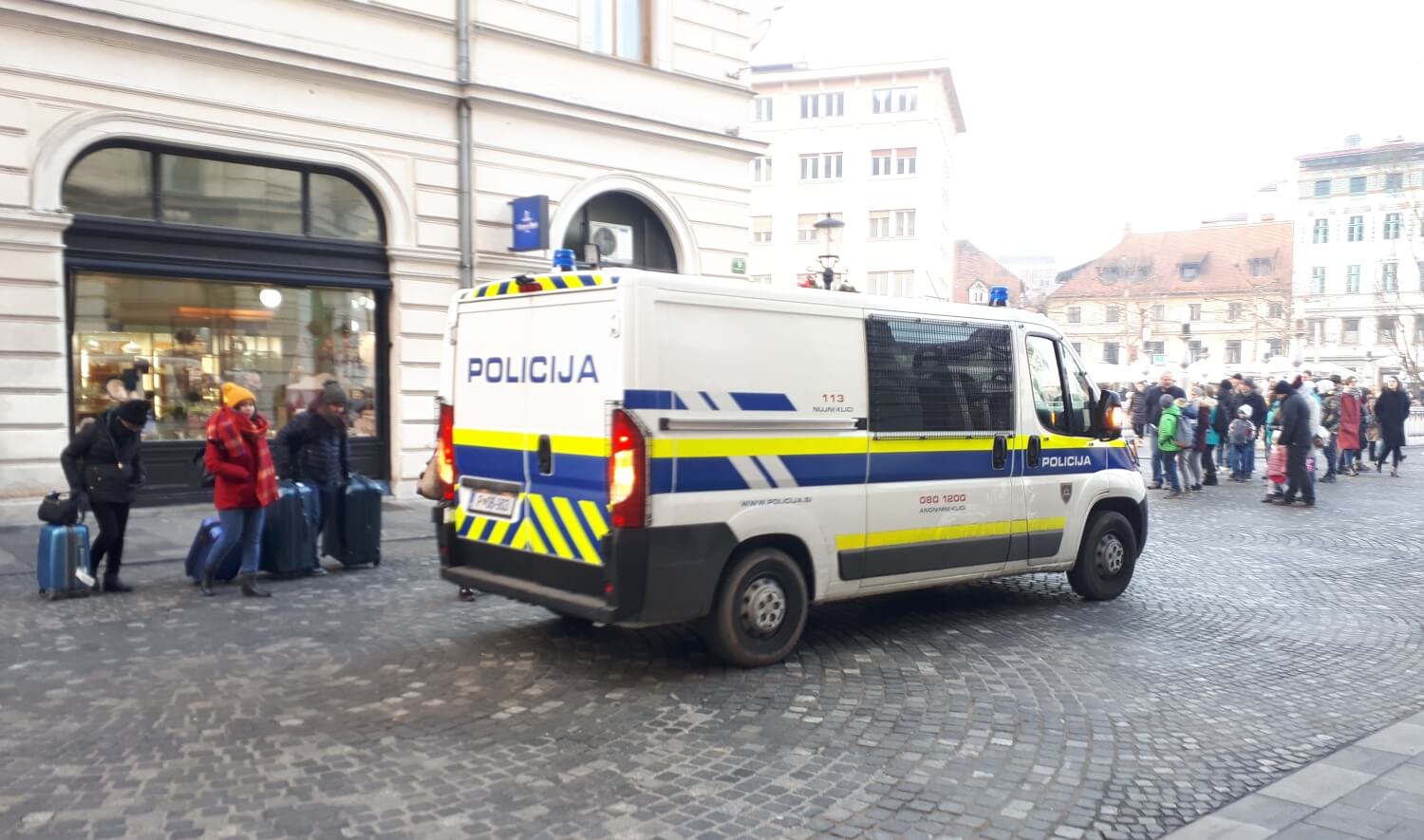
Photo: JL Flanner
STA, 8 May 2019 - Commemorating the liberation of Ljubljana at the end of the Second World War, tens of thousands will take a walk along a marked gravel path surrounding the city on Saturday. A barbed wire used to trace the path during WWII, when Ljubljana was occupied first by Italian and then German forces.
The 63rd Walk along the Wire event will kick off already on Thursday, when kindergarten children will set out to conquer a part of the hike, followed by primary and secondary school children on Friday.
The commemoration's highlight will be Saturday's hike as well as the run of three-member teams, which is not about winning, promoting solidarity and participation. The time of a third member or the weakest link is thus recorded as the team's finishing time.
The running event is also an opportunity for a few laughs, with last year's teams running under witty slogans, such as Turbo Snails, Rolling Stones and (Un)Tamed Shrews.
Instead of stamps the event's organisers would like to gradually introduce a mobile application tracking the teams' progress.
The three-day event is expected to attract more than 30,000 participants, even more than last year, when almost 25,000 hikers and some 5,000 runners participated in the memorial walk.
The accompanying cultural programme will kick off on Saturday morning with a performance of the Partisan choir, honouring the WWII resistance movement. Ljubljana Mayor Zoran Janković will then address visitors, marking Ljubljana Municipality Day, followed by a concert of the Slovenian pop singer Lea Sirk.
The full programme, in Slovene and English, is here
Unlike at the Ljubljana marathon, there will not be many roadblocks, particularly not on Thursday and Friday, with some minor ones and city traffic detours in Ljubljana's centre on Saturday.
A barbed wire was put around Ljubljana in February 1942 by the Italian occupying forces to stop supplies to the Partisan resistance movement.
Ljubljana was the only European capital at the time to be locked out in such a way, with the regime lasting 1,170 days until the end of WWII in 1945 - Ljubljana was liberated on 9 May.
May 9, 2019
Environmentalists warn of imminent drinking water pollution for people living in the municipalities of Bled, Gorje, Žirovnica and Radovljica, whose water source is situated at Ovčja jama water protection area in Pernik.
Water originating from Triglav National Park is, or rather, should be, among that with the best quality in the entire country. Nevertheless, water coming from Pernik now has added chlorine since contamination with faeces was discovered several years ago due to the spread of farming on Mežakla and cutting down of the forests.
This April, a passer-by noticed a loaded truck from a construction company from Kranj driving up in Mežakla and unloading what appeared to be construction waste soil into a sinkhole in the otherwise pristine nature of a protected water area.
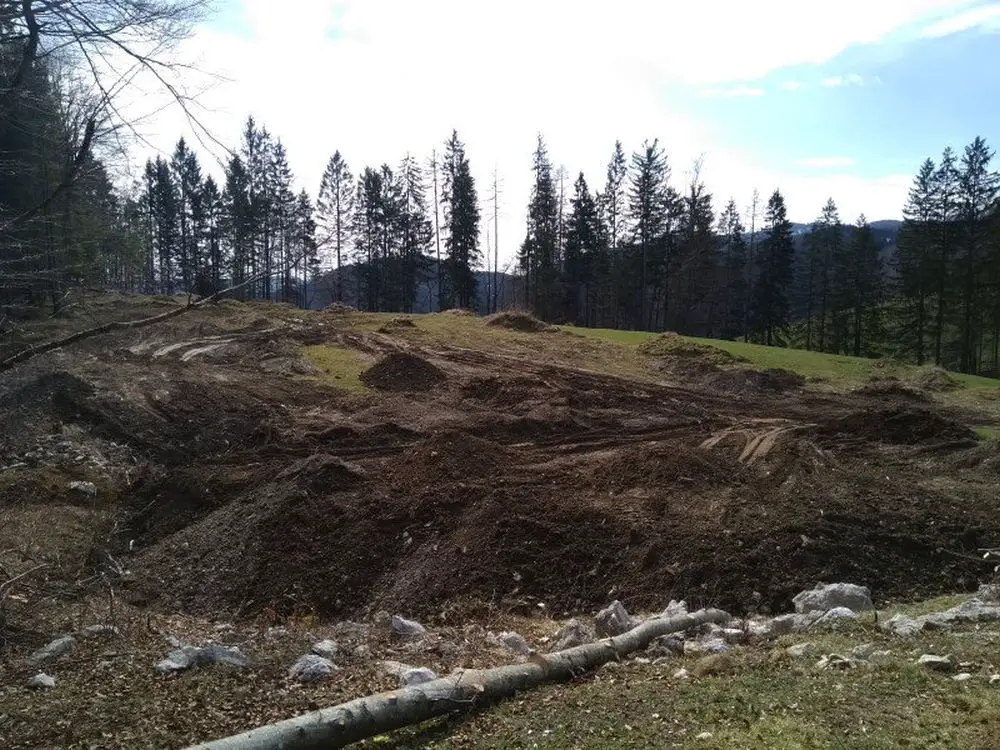
Bled Environmental Protection Society immediately informed the relevant authorities. The same day an inter-municipal inspector managed to catch the driver in action, and prevent any further dumping of the problematic soil.
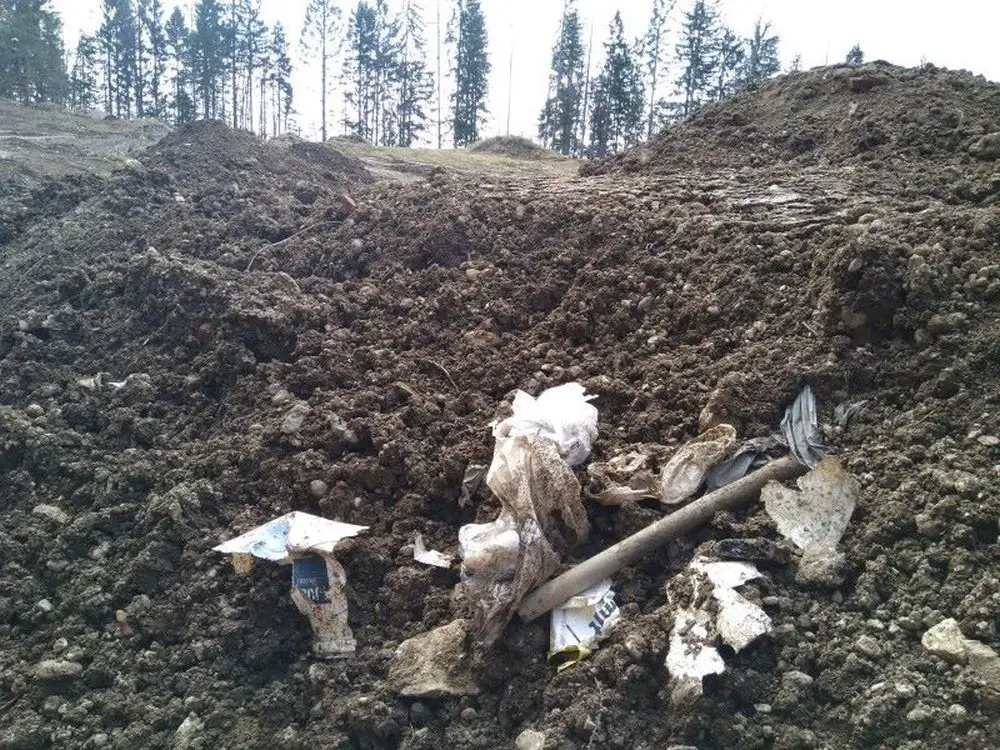
When a few days ago the camera team of the national broadcaster headed to the site to take footage of the waste, the owner of the land first almost ran over the journalists with an excavator, then jumped out and scare them away with a pickaxe. The journalists called the police while the landowner and his son allegedly spent the night in a psychiatric ward in Begunje, claiming insanity.
The inspector ordered the problematic waste soil to be removed by the company that brought it there, while special supervision of the company’s activities has also been launched.
The problematic soil, which includes plastic, plaster, adhesives, concrete, asbestos plates and asphalt, according to the Bled Environmental Protection Society, for now remains where it is. However, according to colourant marker studies, conducted by the Faculty of Natural Sciences and Engineering of the University of Ljubljana, water from the problematic area in Mežakla can trickle down the karst floor to the drinking water wells area in a mere 13 hours.
With Slovenia an official European Region of Gastronomy for 2021, and the tourist board putting its weight behind the promotion of the country’s food and drink offerings, the gourmet traveller or resident can expect to be bombarded with recommendations over the next two years of dishes to try, and places to go. While some of these lists will be thrown together by people who’ve just scanned a review website, or paid a fleeting visit to the country to tick off the most famous names, the same cannot be said for The Slovenia Restaurant Awards (TSRA).
The best fine-dining restaurants in Slovenia
Started in 2016, the winners of TSRA are chosen by an expert panel of Slovenian gourmets and foodies, who know the scene well and are always on the lookout for new talent, as well as returning to acknowledged leaders in fine dining. There’s also a popular element to the selection, with a public vote for the best restaurant in the country.
This year’s winners were announced on Tuesday evening, with the top three, as chosen by an expert panel, being named as Gostilna pri Lojzetu in Vipava, Hiša Franko in Kobarid and Vila Podvin in Radovljica. Hiša Franko – home to perhaps the most famous Slovenian chef, Ana Roš – also won the popular vote.
In addition to the three overall “best in Slovenia”, the event also gave awards by region with, unsurprisingly, some of the same names also appearing.
Alpine region: Hiša Franko, Kobarid
Mediterranean and Kras regions: Gostilna pri Lojzetu, Vipava
Pannonian lowlands region: Hiša Denk, Zgornja Kungota
Central Slovenia: Restavracija JB, Ljubljana
The pick of high-end Slovenian gastronomy
The best hotel restaurant award was given to Restavracija Grad Otočec, while Domačija Belica in Medana was declared the best newcomer. The Best Service Diners Club Exclusive award went to Ljubljana’s Restavracija Cubo, that for Best Social Profile to Družina Bazilika, in Ljubljana. Finally, the blog Jernej Kitchen, run by Jernej Zver and Maja Galuf (with lots of recipes, in English), won the Best Foodie Influence.
STA, 7 May 2019 - President Borut Pahor highlighted the "unforgettable symbolic and actual role" the May Declaration played for Slovenia's independence, as he hosted a reception to mark 30 years since the document calling for the country's sovereignty was read out at a mass rally in Ljubljana's Congress Square.
Since the declaration paved the way to Slovenia's independence, it deserves to have a permanent place in our collective memory, he said at the Presidential Palace on Tuesday.
"Its greatest value is linking democracy, sovereignty and Slovenia's place in an overhauled Europe, which also makes it important for the future."
Admitting that Slovenia would need to keep working on the three goals, he said "all three elements need our encouragement, criticism and debates, but also due cooperation and consensus".
V Predsedniški palači prva državna obeležitev 30. obletnice Majniške deklaracije 1989 za suvereno državo slovenskega naroda https://t.co/RJcLamqTsA pic.twitter.com/21KwDhqU6S
— Borut Pahor (@BorutPahor) May 7, 2019
"We decide on our own state and its democracy on our own, and on European future together with other nations," he said at the first-ever state-level event marking an anniversary of the reading of the 1989 declaration.
"Also today, 30 years on, it is clear that the sovereign Slovenian state, democratic and integrated into Europe, is the basic tool of our existence and development."
He recalled that the public legitimation of the idea about the sovereignty of the Slovenian nation had only been possible during the political spring in the late 1980s. "Before that, it was considered illegitimate."
Just like Dimitrij Rupel, a co-author of the declaration, Pahor stressed the 1989 events had led to the first democratic elections, a referendum on independence, decisions on Slovenia's independence and to the country's international recognition.
Outlining the conditions under which it was written, Rupel said the declaration came into being in his office at the Faculty of Sociology, Political Sciences and Journalism in April 1989.
Writer Tone Pavček was asked to read it "because the Slovenian Writers' Association was the first organisation signed under the declaration and because we did not want it to be interpreted as a manifesto belonging to any of the four [political] parties," said Rupel.
The declaration was also signed by the Slovenian Democratic Union (SDZ), the Slovenian Farmer's Union (SKZ), the Slovenian Christian and Social Movement (SKSG), the Socialdemocratic Union (SDZS), the university conference of the Socialist Youth League of Slovenia (ZSMS) and the Slovenian Composers' Association.
Its name was taken from the 1917 declaration in which Slovenian, Croatian and Serbian deputies demanded living in an autonomous unit within the Austro-Hungarian Empire. The document was read in the Vienna parliament on 30 May 1917 by Slovenian deputy Anton Korošec.
The declaration reading led to independence, but the document would have been overlooked had it not become part of the Committee for the Protection of Human Rights' campaign for the release of all four dissidents from the JBTZ military trial, said Jožef Školč, the then president of the ZSMS.
Since neither the committee nor the ZSMS had a permit for the rally, the declaration was read at what was formally termed an open session of the ZSMS in Congress Square, Školč, who hosted an event on the occasion at the Museum of Contemporary History, told the STA.
"We simply took the risk of holding a session of the sociopolitical organisation and waited if anyone would dare ban it," said Školč, noting they had tried to express their frustration at the second arrest of Janez Janša, now the leader of the opposition Democrats (SDS).
Igor Bavčar, who led the committee, said, as he addressed the event at the museum, the events from 30 years ago were a reminder of what could be achieved with perseverance.
"That was a time full of emotions and unpredictability, of some realistic but often also imaginary dangers and disinformation.
"It became clear what we had avoided only after certain documents were discovered later on," he said, adding a new wave of arrests had been planned but had probably not taken place because of their activity.
Bavčar said the late 1980s and early 1990s had been a time of incredible enthusiasm which brought together people of different ideologies, which he sees as a special value.
Bavčar, who soon became interior minister and later led the Istrabenz conglomerate, is happy with the legacy of the May Declaration.
He is however less happy "with everything that has befallen me, and I'm still fighting against it," he said in reference to his serving a prison sentence for money laundering.
Andrew Anžur Clement is a Slovene-American who lives in Ljubljana and is a prolific author, having published eight books in the last 18 months. His latest has just been released, Tito’s Lost Children, and so we made good use of the short time between one project finishing and another starting in earnest to find out more about the work…
For those who might take the title literally - is this really a book about the "missing" children of Tito?
No. While inspired by the breakup of Yugoslavia, Tito’s Lost Children is a work of fiction. The main characters’ actions are set amid real historical events. They meet real historical figures including Milan Kučan, the first president of independent Slovenia. However, the main characters are not based on real people. Tito’s Lost Children is a ‘What if?’ alternative history where the main character discovers that she is Tito’s daughter and chosen successor, meant to have been raised and trained in secret. The problem is that she was discovered late and never trained. It is now up to her to stop the breakup of Yugoslavia and keep it from being turned into Greater Serbia.
The book is set during the 1990s – what drew you to that period, and what research did you do?
I was drawn to the idea that a story like this could have happened within our lifetimes, in ‘our’ world -- and if you live in Slovenia or the region, maybe just a few blocks down the street!
A lot of the research consisted of watching old footage of things like the Yugoslav Youth relay, and the Slovenian independence ceremony. I travelled to many of the locations in the novel. There are also a number of works that have greatly shaped Tito’s Lost Children (Book One) and the forthcoming books in the series. The highlights are below:
The Death of Yugoslavia by Laura Silber and Allan Little is basically my ‘bible.’ A well-thumbed copy sits next to my computer at all times while I’m writing. It is perhaps the seminal work written in English on the wars and provides a detailed overview.
Related: The Slovenian part of the BBC documentary series on which The Death of Yugoslavia was based
Slovenia 1945: Memories of Death and Survival after World War Two by John Corsellis was indispensable to my understanding of the conflict between the partisans and the domobranci in Slovenia during WWII. I read it by chance while cat-sitting for a friend in Bled; I was glad I did. The plot of Tito’s Lost Children would not have been the same without it.
Related: An interview with John Corsellis
Logavina Street by Barbara Demick provides an enthralling and informative account of what it was like to live through the wars, specifically during the siege of Sarajevo. It has been helpful not only for that, but also for providing details about what it was like to live in the region at the time.
To End a War by Richard Holbrooke is a memoir penned by the man who negotiated the Dayton peace accords, bringing an end to the war in Bosnia. It provides an inside account of the negotiating process and has been helpful as a look into what some of the main political leaders in the region, such as presidents Tudjman, Izetbegović and Milošević, were like in person. My characters will encounter them in the coming two books.
Tito and the Rise and Fall of Yugoslavia by Richard West is by far the best historical overview about the origins of ethnic/religious tensions in the region.
Currently, I am reading The Hotel Tito by Ivana Bodrožić. It’s an autobiographical, first person novel about an internally displaced girl during the wars. It is great character research for one of my protagonists, who has a similar backstory; I’ll leave you guessing as to which one.
Did you do much traveling to the other parts of ex-Yugoslavia?
Yes, but most of it not specifically to research these books. I live in Ljubljana and have been travelling to the region of the former Yugoslavia for over ten years, so it’s more like my travels were the inspiration for the books. I got the explicit idea to write Tito’s Lost Children while on a family vacation in Montenegro and southern Croatia in the summer of 2017. The inspiration for it struck while I was standing on the dais behind Montenegrin King Njegoš’s tomb. I spent the rest of the trip creating the characters and envisioning them inhabiting places like Dubrovnik, the Sveti Stefan resort island and the cliffside Ostrog Monastery. Since then, I traveled back to Sarajevo and Pale in January specifically to do research for the books. I am planning a research trip back to Serbia later this month.
I should mention that the city of Ljubljana figures prominently in Book (War) One. It’s sometimes funny for me to walk around town now. I have associations with what my characters ‘did’ in some places. Cankarjevo Nabrežje? That’s where Hristijan was awestruck when arriving in Ljubljana for the first time. Shoemaker’s Bridge? That’s where Mojca was when the helicopter got shot down during the Ten-Day War. Prešeren Square? Well, I’d tell you, but then I’d have to give a major spoiler…
Aside from the places that mentioned above, many other locations in Ljubljana figure in the second half of the novel once the characters make it to Slovenia – which is a lot harder than it sounds, believe me! They include: the river walk in Trnovo, Congress and Republic squares, and Metelkova when it was still an Army barracks.
I was lucky enough to get a peek inside of the Slovenian Presidential palace when President Pahor opened it to the public on December 26th. It figures as a prominent location during the Ten-Day War.
Outside of Ljubljana, some of the plot is set during the conflict over the Holmec border crossing in the north of Slovenia. The summit of Mount Triglav provides the setting for the climax.
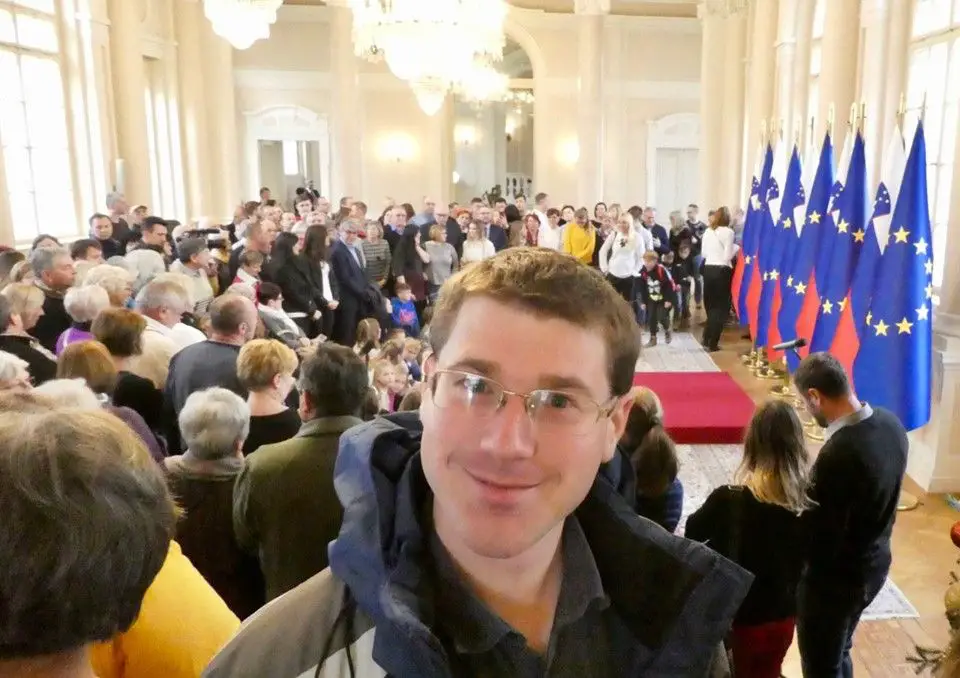
Andrew inside the Presidential Palace. Source: Andrew Anžur Clement
Your earlier works had magic and fantasy, are there any elements of those in Tito’s…?
Nope. No magic or fantasy. Just a lot of hard-core identity politicking among the Yugoslav peoples. Don’t worry, I make it entertaining, if I do say so myself.
This book is subtitled “A Tale of the Yugoslav Wars. War One: Slovenia” – how many books are planned for the series?
Three, one ‘war’ (book) for each of the main conflicts that occurred during the breakup of Yugoslavia in the early 1990s. I currently have a draft of ‘War’ Two, Croatia, which centres on the Sieges of Dubrovnik and Vukovar. I can’t wait to start writing ‘War’ three Bosnia, which centres on the Siege of Sarajevo and the Srebrenica massacre.
I should mention that I also have an idea for a sequel series to Tito’s Lost Children, set in the former Yugoslavia and Brussels during the mid- 2010s. The working title is Daughter of the Federation and it draws heavily on my PhD student days in the EU’s capital city during that time.
How much of the series do you have plotted out, and how much of an outline typically makes it to the final book?
In a general sense the series is plotted out all the way through to the end. In other words, I know how the characters will develop and what happens to them. I tend to deal with their specific internal monologue and how exactly they react to certain events on the fly. As a general rule, I usually know I’m ready to begin writing a new series when I have enough plotted out to know the first and last sentences.
Usually, I whack out 30% of a complete first draft. There are sometimes things in earlier drafts that were only in there because I first had to explain what happened to myself before I can ‘show’ it to the reader. This is just part of the process.
Do you envision a Slovenian edition of the book?
I currently sell the book on mainly Amazon and am focused on the English-speaking market. I wrote these books with the assumption that many people picking it up in the English speaking world might not have extensive knowledge of the region or its history. So, if I’ve done my job, someone should be able to read it without first knowing, say, the difference between a Slovene and a Serb, enjoy the adventure story, and maybe learn a thing or two.
That said, I don’t think that means the book is unenjoyable to Slovene audiences; since the book launched, I’ve been surprised by the amount of interest coming from Slovenes. Someone even messaged Marjan Šarec and Miro Cerar about the book on Twitter! Maybe having a Slovene translation of it would make sense.
Do you think self-publishing like this is a viable way for authors in Slovenia, who are a long way from traditional publishing centres, to produce, market and sell their work?
If we’re talking about self-publishing on an online platform like Amazon, I would say it’s the best way out there if we’re talking about the international market. It bypasses the London and New York-based agents and publishers and gets your ideas out there right away.
If we’re talking about sales in Slovenia, where ebooks aren’t so popular, I have heard that self-publishing print books with what in the US would be called a ‘vanity press’ and then selling them through online advertising is much more viable because of the smaller size of the market.
Anything else you’d like to add?
As an indie author I live and die by reviews; while I’ve sold plenty of books hardly anyone seems to leave them. Tito’s Lost Children: War One is available for less than the cost of a couple of rides on the Ljubljana bus system. I’d appreciate it if readers could get in touch by leaving a review on Amazon, even if it’s just a sentence or two to let me know their thoughts.
You can pick up a copy of Tito’s Lost Children on Amazon, now on discount for a limited time or free to read with Kindle Unlimited. You can also see Andrew’s other books here.
STA, 6 May 2019 - The newspaper Delo noted in Monday's editorial that it is commendable that Slovenia is the third most popular destination for workers from the Balkans, but also warns against overpopulating the country with foreigners, wondering "whether Slovenia should leave the door fully open for all".
Young people are leaving Serbia, Bosnia-Herzegovina, Macedonia and Kosovo as they are demoralised, they do not see any future at home, the paper says under the headline Our Own Ground Under Our Feet.
People are also leaving Croatia en masse, although the country is doing much better than its neighbours. What contributes to this is also the overall globalisation, with young people emigrating all over the world.
Slovenia is the third most popular destination for people from the Balkans for life and work, after Switzerland and Germany, which is actually commendable for the country. It means that life is good in Slovenia, the paper notes.
If Slovenia needs foreign labour force, citizens of the former Yugoslav republics are certainly the most favourable immigrants. Slovenians have many things in common with them, but there are also differences, because of which the former state disintegrated in the first place.
Delo says that the current increase in immigration should be analysed. "If it continues, in ten years a quarter of Slovenia's population will be foreigners," it says, adding that mechanisms for the integration of every foreigner individually should be established.



